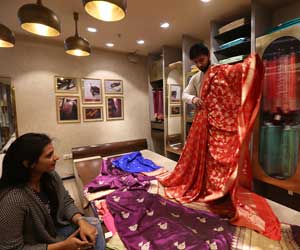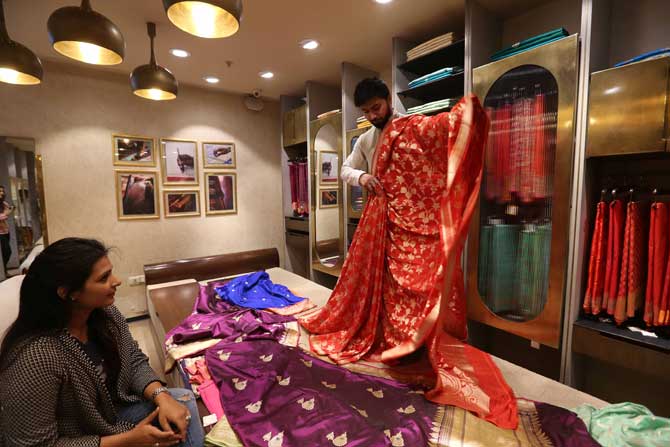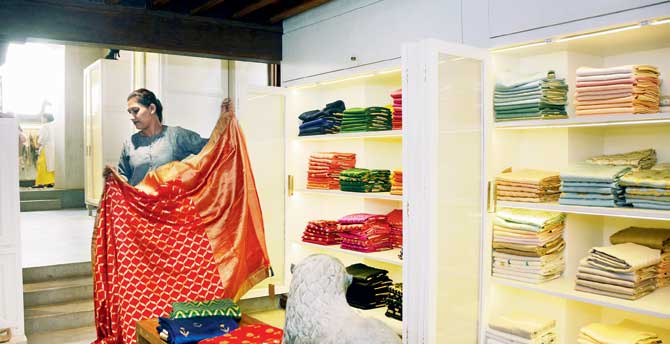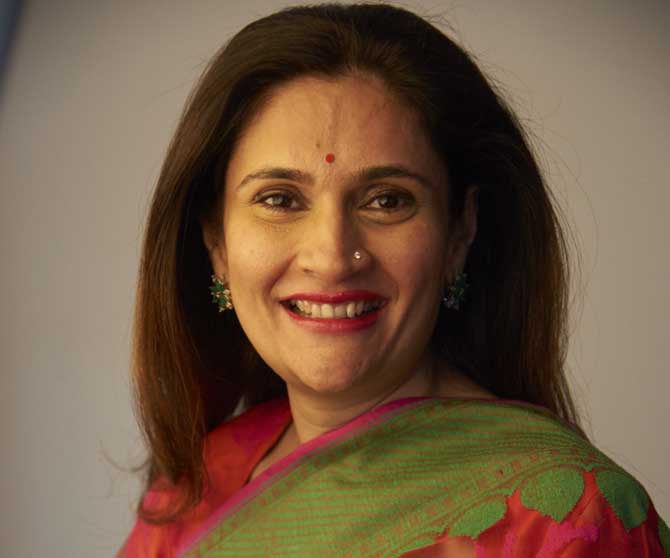The revival of handloom sarees, nudged forward by Indian designers and the government, also means that the way in which you buy a six-yard is going back to basics

A walk down Hindmata cloth market in bustling Dadar is as much an open invitation to a performance as it is to shopping. One side of the street is lined with cubbyhole saree shops, all wholesale, their walls stacked with folded six yards from ceiling to floor. The salesmen sit around the edges, the customers usually at the center, as they pull out piece by piece, unraveling each before the buyer. The transaction is an equal one, with both salesman and customer sitting on a cotton mattress lined floor, a heap of sandals at the entrance signaling to approaching buyers that they must wait their turn.

Ekaya's Defence Colony store replicates old-world gaddi seating, where the salesperson opens out saree after saree before the customer, even draping it on himself to offer her an idea of fall and finish
ADVERTISEMENT
This has been middle-class India's saree shopping experience for centuries. To cater to the privileged saree wearer, however, the set-up was raised a few feet off the floor. The shoppers at Kala Niketan or Nalli's sit on chairs while the salesman unravels saree after saree on a tabletop lined with a cotton mul mattress not very different from the one you sit on.
The modern shopping experience, however, meant that sarees too, especially the precious designer ones, would be sold like western garments, on hangers. Customers would browse, pull out what they liked and drape something that particularly caught their fancy, in a plush changing room.
The last few years have seen a revival of interest in the saree, especially in urban centers, and designers working directly with clusters of weavers are to thank for making some noise around traditional weaves.
Interestingly, going back to ancient techniques of weaving, and the resurgence of antiquated motifs also means that designers are rethinking how the saree will be sold.

The Raw Mango store at Apollo Bunder stacks sarees in almirahs, much like they would sit in someone’s home
Shah Narayan Das, one of Benarasi brocade's oldest champions, has retailed its creations from Varanasi's most famous market at Chowk. Their brand Ekaya, which Bharat Shah's daughter Parul now helms, retails out of a fancy twin-level boutique at Delhi's Defence Colony. A new Hyderabad store was launched last week, and the Shahs were clear that hangers were out and gaddis, in.
Architect Ambrish Arora was handed a brief that challenged him to recreate Varanasi's old world charm of saree hawking but in a luxurious environment. Corners of the store are used to station a diwan where the customer makes herself comfortable, while the salesman alternates between standing and sitting on a gaddi before her, pulling out folded sarees from a shelf behind, and unraveling Benarasis scattered with butis, bels and jaalis. "The experience is identical," says Payal, "except that you sit on a cushion-lined diwan. State your preference and the gaddidar will find you your preferred drape."
Having traded in Benarasis for four generations, the Shahs realised that while India was used to a traditional saree retail experience, the overall luxury fashion business had seen drastic changes in the last five years. "The saree is not a garment any longer. It's considered couture. We've upgraded the shopping experience to evoke a sense of luxury while purchasing a saree, but borrowed from the past," Payal says.

Sagrika Rai got composer Dr Prakash Sontakke to come up with an original instrumental score to play at her store. The cluck of the loom, the swish of boats that bob on the Ganga, play in the background as Rai’s clients make their purchase, sipping on Banarasi thandai or chai
Sanjay Garg of Raw Mango, an indigenous label that works at contemporarising ancient weaves, has traded prawling gaddis for minimal furniture, although the spirit of retail remains traditional. White almirahs lined along the walls of a sparse showroom at Mumbai's Apollo Bunder hold within they folded Chanderis and Benarasis in the juiciest of colours. "Classical definitions of lifestyle have changed, as has saree retail. For instance, nobody calls it 'baithak' anymore; it's a drawing room. Gandhiji wondered if English would become our national language some day, and I think it has. We have begun to think English."
But his flagship store in the city reflects Gandhi's frugal aesthetic, with whitewashed walls and metal beams.
"Dust is a common problem in our country, so open display was out of the question," he explains explaining why he didn't choose hangers for his creations. "Hence, the idea of an almirah. We urge our clients to treat it like their own." he adds. And so, unlike other stores where you touch and feel what the salesperson curates for you, Garg wants you to feel at home while browsing through the stash inside the almirahs.
His New Delhi store, of course, retails the saree in a more decadent setting, with gaddas and floor cushions inviting customers to relax on the floor. "The buzz around sarees has led designers, who otherwise specialise in Western wear, to work on drape as well, and sell it in a modern set-up. It's not uncommon to hear them scoff at my store interiors, calling it an old-style saree shop. But that's perfectly okay," he shrugs.
Saree revivalist and author of Saris of India -- Tradition and Beyond, Rta kapur-Chisti puts the retail experience shift in context. "The retail game has changed over the last eight years. The market is flooded with sarees in delicate georgette and chiffon, weighed down by rhinestones and sequin. They are so fragile that stacking them can damage them." She says that the way in which a saree is folded signals its tenacity. Bengal weaves are always rolled up while the Gadwal saree's uniqueness allows it to be folded to fit into a matchbox. "Large boutiques and several designers are concerned with meeting the demand for these heavily embellished sarees, leaving stores with little choice but to drape them on mannequins or display them on hangers," she says.
Sagrika Rai, who has been championing the cause of the Benarasi since the 1990s, and runs Warp & Weft at Marine Lines, says the saree buyer enjoys the experience of a salesman catering to her instead of female staffers, just like in the small towns. "They love the attention," she laughs. She may have her sarees stand on hangers, but the smells and sounds of the ghats of Varanasi are very much around. Rai, who spent her childhood in the temple town, got Dr Prakash Sontakke, an old friend and co-composer of the Grammy winning album, Winds of Samsaara, to come up with an original instrumental score to play at her store. The cluck of the loom, the swish of the boats that bob on the Ganga, play in the background as Rai's clients make their purchase, sipping on Banarasi thandai or chai.
What you serve is as important as what you serve it in, Garg smiles. At his store, tea and coffee are served in glasses on a distressed brass thaal. It's not surprising that enticed by the experienced, his clients have warned him, "Boss, you change or modernize the store, and we are off!"
 Subscribe today by clicking the link and stay updated with the latest news!" Click here!
Subscribe today by clicking the link and stay updated with the latest news!" Click here!







